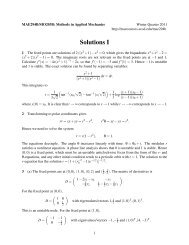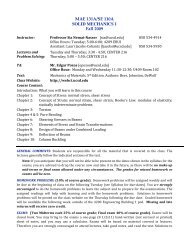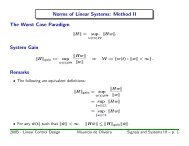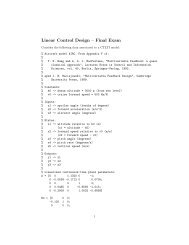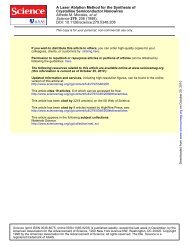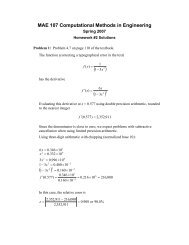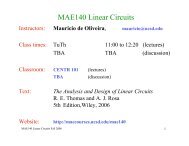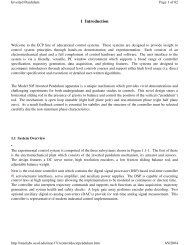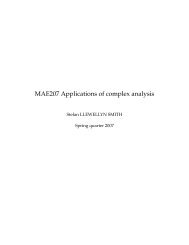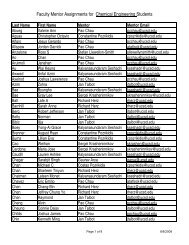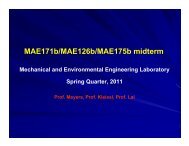Homework
Homework
Homework
You also want an ePaper? Increase the reach of your titles
YUMPU automatically turns print PDFs into web optimized ePapers that Google loves.
MAE 101B, Spring 2009<br />
<strong>Homework</strong> 1<br />
Due Thursday, April 9, at 5 pm in EBU I office 2205<br />
Guidelines: Please turn in a neat homework that gives all the formulae that you have used<br />
as well as details that are required for the grader to understand your solution. Required<br />
plots should be generated using computer software such as Matlab or Excel.<br />
Please refrain from copying. Refer to the course outline for what constitutes<br />
copying<br />
Use the following fluid properties:<br />
water: ρ = 1000 kg/m 3 ; µ = 0.001 kg/m − s.<br />
kerosene: ρ = 820 kg/m 3 ; µ = 0.0016 kg/m − s.<br />
glycerin: ρ = 1260 kg/m 3 ; µ = 1.49 kg/m − s.<br />
1. The laminar fully-developed flow ( low Reynolds number) in a channel between two infinite<br />
plates at y = ±h is:<br />
u = h2 <br />
∆p<br />
1 −<br />
2µl<br />
y2<br />
h2 <br />
. (1)<br />
The flow is in the +x direction, and the quantity, ∆p, is defined to be positive.<br />
a) Start from the incompressible Navier-Stokes equations to derive Eq. (1).<br />
b) Start from Eq. (1) to derive a relationship between the friction factor, f, and the Reynolds<br />
number, Reh = V h/ν.<br />
2.<br />
a) Glycerin flows with a given volume flow rate Q = v · ndA = πD 2 V/4 through a horizontal<br />
pipe (1) of diameter D1 that connects to pipe 2 of diameter D2, as shown in figure 1. The<br />
pressure drop per unit length (∆p/L) in pipe 1 is measured to be 81 times smaller than in<br />
pipe 2. What is the diameter ratio D2/D1? Does your answer change if the fluid is water<br />
instead of glycerin? Why? Assume laminar flow in both cases.<br />
b) Consider the same geometry as in part (a) and let Q = 2 m 3 /s. It is desired that the flow<br />
be laminar. What is the minimum value of D1 given D2 = D1/3 ? What are the pressure<br />
drops per unit length under these conditions?<br />
3. A fluid flows through a horizontal tube of length 20 m, and diameter 0.2 mm. The power<br />
delivered to the pipe by a pump is Ws = 0.1 hp.<br />
a) If laminar flow is desired, should the fluid be water? how about kerosene? Justify your<br />
answer.<br />
b) Compute the wall shear stress if the flow with the fluid chosen in part (a) is at laminar<br />
transition point (Re = 2300).<br />
4. Water flows upward at 10 m/s in a 5 cm diameter 5 m long pipe from point 1 to point 2. The<br />
pipe is tilted upward at angle α = 30 ◦ to the horizontal plane. A pressure transducer reads<br />
50 kP a at point 1 and 30 kP a at point 2. No power is being delivered to the pipe (Ws = 0).
a) Are the readings consistent? Justify your answer.<br />
b) The correct reading at point 2 is 20 kP a. Compute the head loss and the friction factor.<br />
5. Glycerin enters a diverging circular nozzle at contant volume rate Q = 1 m 3 /s. The diameter<br />
of the nozzle D(x) is given (in m) by<br />
D(x)<br />
L<br />
= 0.5 + 0.1 x<br />
L ,<br />
where L is length of the nozzle. The fluid exits the nozzle at laminar transition point<br />
(Re = 2300).<br />
a) What is the length of the nozzle?<br />
b) If the pressure is constant across the nozzle, what is the head loss?<br />
Ungraded problems From text. 6.27



